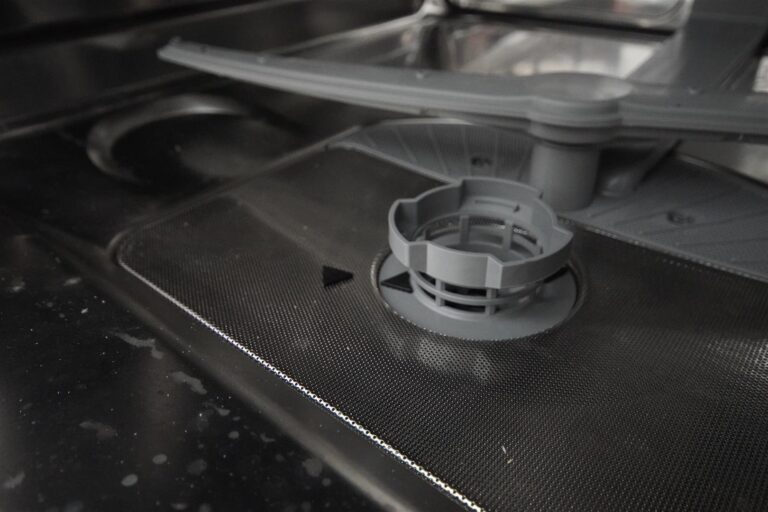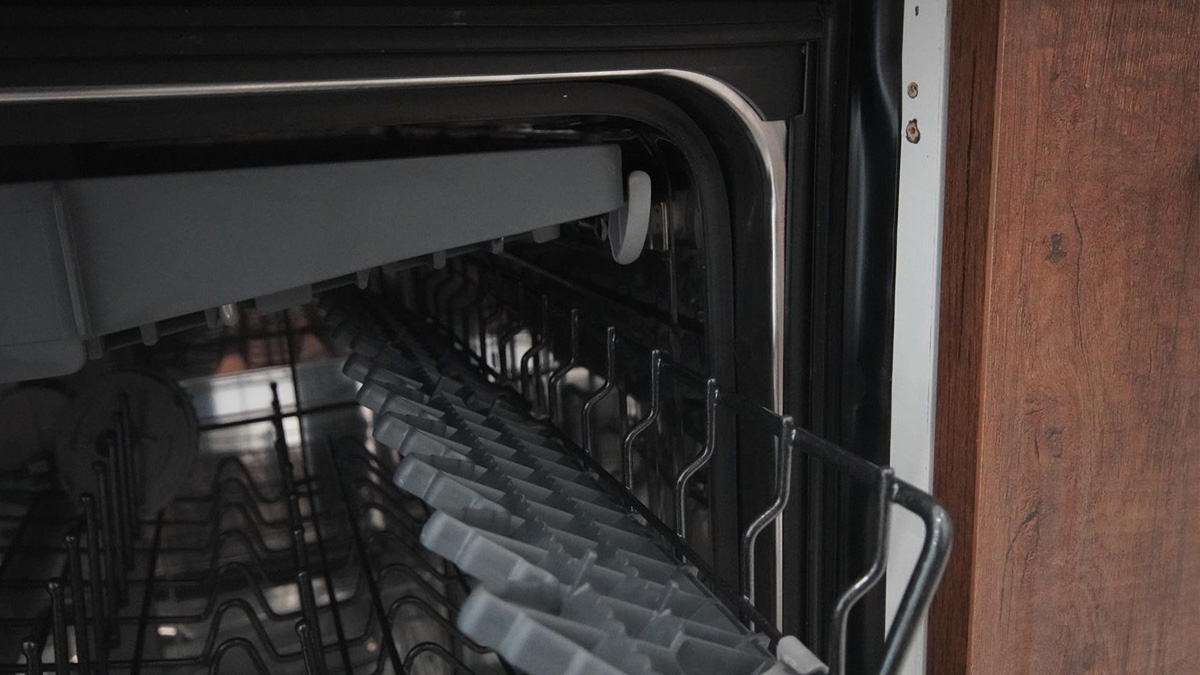Is Your Dishwasher’s Door Wetting the Floor?
Maybe your kid, thinking he’s original, wrapped a rubber band around your sink’s sprayer. Or someone dropped ice cubes from the freezer onto the floor and neglected to pick them up. Or maybe your dog steps on his water dish and spills it all over the kitchen. Whatever the source, you now have to clean up your wet floor (and gently chastise the perpetrator). When you run your dishwasher, you want to just set it and forget it. But sometimes it’s the dishwasher that wets the floor and chastisement, gentle or otherwise, can’t help you with that leak.
Dishwashers can leak in several ways. Here are some things that could cause your dishwasher door to leak, and potentially cause water damage in the process:
Dishwasher Door Has a Bad or Failing Seal
Sometimes a broken seal is just one load; sometimes every load. Give the dishwasher the benefit of the doubt before you blame the gasket, but look there first.
How old is the gasket? Is it the original gasket, or has it already been replaced before? Depending on the material it is made with, the amount of usage it gets, its design, and the manufacturer of the equipment, gaskets could last 5 years before one needs to be replaced. However, they can last many more years than that as well, perhaps even the life of the dishwasher. The life of a dishwasher is typically around 10-13 years. Since gaskets are exposed to heat, water, falling dishes, kids, and are exercised every time the door is closed and dishwasher run, they are especially vulnerable. Look for signs of trouble and try another load.
Sometimes it’s as simple as food getting stuck on the gasket and breaking the seal creating a leak. But if it looks clean, what you’ll want to do is inspect the entire thing. Look for cracking. See if it is still pliable, and make sure it is secured completely. If your gasket has screws, make sure they are tight. Sometimes they use only glue; if so, check for failure there. If it is cracking, brittle, unforgivingly stiff, missing any portion, or not secured to the appliance all the way around the door, then it’s time to replace it. Check with the manufacturer or a retailer and see about replacement parts. It’s a job many people can do themselves if they’re handy.
If the gasket is clean, and appears in good condition then we need to start looking for other problems.
Another Culprit Is the Sprayer Arms
You know that spinny thingy at the bottom of the dishwasher? (There is usually one at the top too.) Sprayer arms. When broken, cracked, or stopped, these can cause too much water to focus on the door and overtax the gasket and cause a leak from your dishwasher.
Broken or cracked makes sense, but the way you load the dishwasher needs to be considered too. If something is blocking the spinner arm and prevents it from spinning, it can focus a stream of water right at the door. Instead of washing dishes, it starts to wash your floor.
It could be a really large popcorn bowl (because there is no point to a small popcorn bowl) which blocks the upper sprayer arm, or on the bottom shelf, a spoon, metal chopstick, or other utensil is playing a prank (because it can’t reach the spray hose at your sink) it reaches through the floor of the rack and wedges itself to block the lower sprayer arm. Now the sprayer is stuck and directing a steady stream of water at the bottom of the door and the gasket just can’t hold it.
If the sprayer arms are found innocent, it’s time to look at some other causes.
The Person Loading the Dishwasher Might Be to Blame
Deflection! If you are the one loading the dishwasher you might want to deflect blame, but really, it may be a deflection of water because of how you loaded the machine.
Water sprays at the salad bowl, the salad bowl redirects the flow of the water toward the door, and the force of the water is too much for the gasket to contain. Overloading your dishwasher can have the same effect. Water gets blocked by one dish and redirected in another direction. Not only can you end up with water leaking on your kitchen floor, but some dishes never get clean. That’s just adding insult to injury. If you have a hard time closing the dishwasher’s door after loading it, you might want to re-evaluate your loading job.
If you’re at fault, I’m sure you can find a gentle enough way to chastise yourself. On the other hand if its another member of the household who loads the dishwasher, its an opportunity to study fluid dynamics together, and get to know your dishwasher. Reviewing the owner’s manual for their loading recommendations might be time well spent.
Too Much Water in the Basin
There is an inlet valve that allows the water to flow in. It stops the flow of water into the dishwasher when the little guy in the dishwasher’s brain says it has what it needs. Sometimes that valve will go bad. When a dishwasher inlet valve goes bad it will start staying out past curfew, steals money from your purse, and it will not shut off the water when the dishwasher has enough. Now you get an overflow and it starts pouring water out through the door onto your kitchen floor.
When this happens, you need to just replace it. It might tell you it’s doing you a favor and trying to help you with mopping the kitchen, but don’t buy into that. You don’t need no punk inlet valve telling you when to mop the floors. Just get it changed out. By the way, the same goes for when it ignores curfew and starts stealing money. Some parts can benefit from reform school, but not the inlet valve. Once it’s gone bad, it’s a lost cause.
If, after a load is complete, you still have standing water in the basin, it’s likely that the problem has to do with drainage. That is another topic, but you might want to look for plugged drain pipes, the food filter (if your dishwasher is equipped with one), or the pump that forces the water into the home’s drain pipes.
Another ‘Take’ on Too Much Water in the Basin

The float switch is a device that lets the dishwasher know when the basin has enough water. It is designed to float in the water that comes into the dishwasher, and when it has floated enough, it tells the dishwasher to stop adding water. Sometimes it is bad and needs to be replaced. But sometimes it can get stuck or blocked by something either protruding through the dish rack, or something that fell into the basin that you didn’t see. In that case, it’s easy enough to resolve. Make sure it’s clear and if it still doesn’t work, it will deserve closer attention.
The dishwasher door can do its job of keeping water inside if there isn’t too much water. But an overfull basin mixed with the machine’s heat and vibration and you can expect it to start seeping through.
Mold, Water Damage, ‘Ain’t Nobody Got Time for That’
If you have a leak in the door that isn’t too much water, you can clean it up and all is well. But if you let the water sit it can cause decaying of the wood and make a nice growing environment for mildew and other molds. The smell of mildew and mold is unpleasant, but many people also have respiratory and allergic responses that can be life-threatening in severe cases.
Mold spores are everywhere. What makes them dangerous is their concentration. When you have an environment where mold can grow, you’re inviting the concentration to become problematic. So even if the water doesn’t get soaked into your cabinet or other wood surfaces, mold can grow on just about everything. It needs moisture, darkness, warmth (all of which your dishwasher is providing), oxygen, and a food source. Wood, drywall, cotton, are all excellent food sources, but dust, and that doggy treat that bounced under there when you were trying to teach Fido some neat tricks. But in truth, mold doesn’t need much for food. If you have tile, that might grow less mold than drywall and wood, but it can still provide a nice environment for mold spores to multiply by the billions. Yeah, seriously. BILLIONS.
What If…
If you have a water leak in the door because of a bad gasket or too much water, you’ll see it, clean it up, and avoid the growth of mold. But suppose you filled the dishwasher Sunday night, locked the door closed and started a cycle. Then, because of your early flight Monday morning, you don’t even stop in the kitchen on your way to the airport. You never see the dishwasher leak and you come home several days later with water that has been pooling on the floor for days. That’s more than enough time to grow mold or make your cabinet soggy.
Water damage to hardwood floors and kitchen cabinets can develop over time. Excess water in the wood will cause it to swell, and when it dries out it contracts. This can cause warping, cracking or splitting, decay, discoloration, and cupping. Cupping is where the boards swell together causes the sides of the boards to rise higher than the centers of the boards. If the moisture problems are resolved early enough, cupping can be reversed. But it can also be permanent damage to your hardwood floors. Say goodbye to sliding around your kitchen in your socks.
Conclusion
Prevent problems before they become severe. The dishwasher door is easy to work on because it has easy access. When an emergency does happen, and you have a flooded kitchen, you can call a professional like ConstrueMax. We’re not going to fix your dishwasher, and we aren’t going to hand wash your dishes until you get it fixed. But we’ll be there to help you clean up and dry out.
We hope you never need our services. But if the unexpected does happen, Relax, and Trust Construemax.









